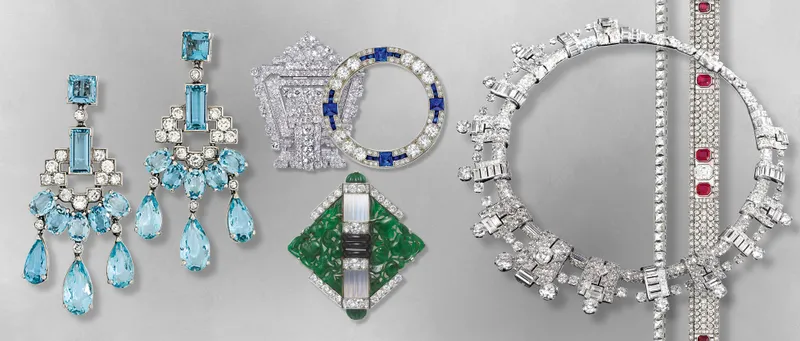Thanks to films such as The Great Gatsby and period dramas like Downton Abbey offering an insight into how the fabulous jewels of the period were worn, Art Deco jewellery has made a comeback.
Art Deco jewellery has recently soared in value with buyers and collectors seeking out original pieces by Cartier, Van Cleef & Arpels, Boucheron, Chaumet and Tiffany.
What is Art Deco Jewellery?
Art Deco jewellery refers to jewellery manufactured between the two world wars. In other words the ‘modern’ jewellery designs of the roaring 1920s and opulent 1930s.
Women, freed from the corset and rigid social conventions, cut and shingled their hair and wore shorter flimsier skirts and drop-waisted shift dresses.
The female silhouette in the 1920s was slim-hipped, flat-chested and androgynous. Historic heirlooms did not suit the new fashions so new jewels were designed to complement them.
Art Deco jewellery is recognisable by its striking geometric lines and bold colour combinations. It was a rejection of the overpowering naturalism of Art Nouveau and the delicate, pastel-coloured froth of the belle époque. It was daring and distinctive then and still looks eye-catching and contemporary today.
What were the key Art Deco jewellery pieces?

Tiaras were swapped for bandeaus worn low over the brow and long pendant earrings appeared beneath the new short hairstyles.
Long beaded and tasseled necklaces and gem-set sautoirs filled plunging necklines and the gaps created by backless evening gowns.
Brooches were worn in new and inventive ways: at the shoulder, hip and waist, on the small of the back or even pinned to hats.
One of the most recognisable pieces of Art Deco jewellery is the double-clip brooch. It's a geometric plaque of two interlocking parts designed to be worn as one or separated on each lapel or either side of a neckline. Bracelets – either of geometric links or huge, clattering bangles – were worn by the armful.
What influenced Art Deco trends?

The First World War caused seismic political and social change. Empires had fallen along with the millions of ‘doomed youth’ on the battlefields.
While the men were away fighting, women kept things going at home by assuming jobs and roles that were traditionally undertaken by men.
After the war, these women wished to remain employed and independent, with the right to forge their own destinies. Rigid Edwardian class and social codes were now outdated and the new fashions suited these women’s emancipated outlook.
The Art Deco period also saw major technological advances. The modern world became more industrial and consumerist; it was the age of speed and mechanisation.
Fauvism, cubism and futurism all influenced jewellery design, as did the exoticism of distant cultures. Motifs from Chinese, Japanese, Indian, Persian, Assyrian, African, Greek and Islamic cultures were all thrown into the melting pot.
In 1922, the discovery of the tomb of Tutankhamen sparked a global media frenzy and its impact on the arts was far-reaching.
The fashionable women of Paris, London and New York might wear jewels inspired by ancient Egyptian motifs to offset their Hathor wraps or Carnarvon frocks while dancing to the Tutankhamen Rag.
Above all, the inter-war period was a time to live and forget the past. The Wall Street Crash of 1929 contributed to a worldwide financial slump but, paradoxically, the 1930s was a decade that saw the production of huge, opulent jewels.
Which materials were used?
The best quality Art Deco jewellery pieces were mounted in platinum and covered in gemstones. The deceptively simple geometric lines of the piece were often a foil for technical artistry that combined numerous cuts of stone in the same piece.
The baguette cut had been used by Cartier since 1912 and was now combined with the brilliant and square cuts. More elaborate pieces used up to six different cuts.
Diamonds were also combined with non- or semi-precious materials, such as black enamel or lacquer, to create a striking chromatic contrast.
Often many different coloured gemstones, such as lapis lazuli, coral, onyx, jade, rubies, sapphires and aquamarine, jostled for attention in the same piece. The 1930s was also the decade for huge, sculptural ‘white’ jewels, set only with diamonds.
Art Deco jewellery pieces to look out for

Paris was the centre for jewellery manufacture and the very best Art Deco pieces tend to be French, handmade by skilled craftsmen in numerous workshops.
However, Art Deco jewels were produced internationally in varying degrees of quality and at all prices. Precious examples were copied in paste and silver and mass-produced in factories. New plastics, such as Bakelite, emulated amber but also became an art form in their own right.
Cartier was the jeweller par excellence. Run by three brothers, it had branches in Paris, London and New York. It had an elite clientele of European aristocrats, American billionaires, Indian maharajas and Hollywood celebrities – all with a common desire for sumptuous jewels.
Other well known jewellery houses that produced superlative examples were Boucheron, Chaumet, Mauboussin and Van Cleef & Arpels.
There were also more avant-garde ‘artist-jewellers’ such as Fouquet, Templier and Sandoz, who incorporated the shapes of car wheels, machine parts and architectural details into their designs.
What is the price of Art Deco pieces today?

A century later, Art Deco jewellery still seems incredibly distinctive, modern and contemporary and the quality of manufacture in the best examples is second to none.
Art Deco jewellery can fetch prices from several hundred pounds to several million, depending on the maker, the size and quality of the gemstones, and the uniqueness of design.
The increasing popularity of period dramas featuring these fabulous jewels has created a vogue among auction buyers to own distinctive pieces from this glamourous era.
More content from Homes & Antiques
- Where to buy antique silver and jewellery online
- Collecting antique and vintage cocktail watches
- A guide to buying vintage engagement rings
Sign up to our weekly newsletter to enjoy more H&A content delivered to your inbox.





